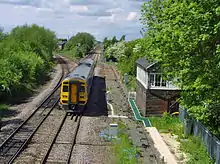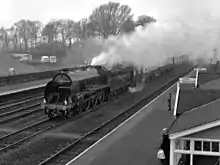Gilberdyke | |
|---|---|
 The station in 2009 | |
| General information | |
| Location | Gilberdyke, East Riding of Yorkshire England |
| Coordinates | 53°44′52″N 0°43′48″W / 53.7479°N 0.7300°W |
| Grid reference | SE837286 |
| Managed by | Northern |
| Platforms | 2 |
| Other information | |
| Station code | GBD |
| Classification | DfT category F2 |
| History | |
| Opened | 1840 |
| Passengers | |
| 2018/19 | |
| Interchange | 338 |
| 2019/20 | |
| Interchange | |
| 2020/21 | |
| Interchange | |
| 2021/22 | |
| Interchange | |
| 2022/23 | |
| Interchange | |
| Notes | |
Passenger statistics from the Office of Rail and Road | |
Gilberdyke railway station is a railway station that serves the village of Gilberdyke in the East Riding of Yorkshire, England. It was opened in 1840 by the Hull and Selby Railway, and until 1974 it was known as Staddlethorpe station.[1] Today it is operated by the Northern train operating company. Situated 17 miles (27 km) west of Hull, it is the junction for the lines to Selby and to Goole and Doncaster.
History
Staddlethorpe station was opened by the Hull and Selby Railway in 1840. The original facilities included a water station, with a 1,250,000 imperial gallons (5,700 m3) reservoir and pumping engine.[2]
In 1842 a train guard slipped in wet weather, falling off the platform under moving coal wagons, resulting in very serious injuries leading to his death.[3] In 1850 a train from Hull to Normanton had one of its engine's boilers explode near the station. Both the driver and fireman were badly scalded, and the fireman broke a leg.[4]

In 1869 the Hull and Doncaster Branch opened, branching south-westwards from a junction just west of the station.[5][6]
At around the end of the 19th century a goods shed, and sidings serving a creosote works were established south of the station. In the same period the line through here and on towards Brough was increased to four tracks.[6][7] The reservoir was filled in during 1903.[8] In 1987, the platform loop lines were removed (reducing the line to two tracks again) and the platforms themselves extended outwards to reach the remaining running lines.[9]
The works and area south of the station was redeveloped as an industrial estate in the 1970.[10]
In 2006 a planning application was accepted for the demolition of the goods shed and the erection of three industrial units split into eighteen smaller business units.[11]
Present
Railway buildings that still exist include the Station Master's house and two adjacent cottages, and, on Broad Lane, a number of terraced cottages known as Station Cottages. The sidings south of the station have been replaced by an industrial estate "Gateway Business Park".
The station is now an unmanned halt and has no ticketing facilities – passengers must purchase these on the train or prior to travel.[12] Shelters are located on each platform, along with digital information screens. Train running details can also be obtained by telephone and timetable posters.
The station does not have step free access to the westbound platform (as it is accessible only via footbridge), meaning that disabled passengers should book assistance in advance or travel via Brough station where step free access is available.
Services

The station is operated by Northern. The station is served hourly in each direction on weekdays by local trains between Hull and Doncaster and by the York to Hull via Selby service, along with a limited service (one departure per day) to Leeds and Liverpool Lime Street operated by TransPennine Express. This is the 1K04 service leaving Hull at 04:59 Monday to Saturday calling at Gilberdyke at 05:18 in the December 2022 timetable.[13]
On Sundays, the main service is provided by the Hull to Doncaster trains, though two York services also stop – one in the morning and the second around noon.
| Preceding station | Following station | |||
|---|---|---|---|---|
| Northern | ||||
| Northern | ||||
| Howden Selby on Sundays |
TransPennine Express North TransPennine |
Brough | ||
References
- ↑ "For Staddlethorpe read Gilberdyke". The Railway Magazine. 1974. p. 96.
- ↑ Whishaw, Francis (1842). The Railways of Great Britain and Ireland Practically Described and Illustrated (2nd ed.). J. Weale. p. 166., alt. link
- ↑ Report of the Officers of the railway Department. Vol. 13. William Clowes and Sons. 1843. Appendix I. Returns of Accidents – Hull and Selby Railway, p.2.
{{cite book}}:|work=ignored (help) - ↑ Appendix No. 25 York and North Midland Railway Bursting of a boiler of a locomotive engine (September 13, 1850). Reports of the commissioners (Report). Vol. 3 of 9 in v.30. 4 February – 8 August 1851. p. 36.
- ↑ Hobson, Bernard. East Riding of Yorkshire. Cambridge University Press. p. 144.
- 1 2 Ordnance Survey. 1:2500. 1890
- ↑ Ordnance Survey. 1:2500. 1909
- ↑ The Journal of Botany, British and Foreign. Vol. 41. 1903. p. 116.
.. the large pool near Staddlethorpe Station [.] has been filled up by the North-Eastern Railway Company for railway improvements.
- ↑ "Humberside’s semaphore swansong" David, G Railwayworld.net 12 August 2017; Retrieved 29 December 2017
- ↑ Ordnance Survey. 1:2500. 1970–1, 1981
- ↑ "(06/07590/STPLF) Erection of 3 buildings containing 18 No. industrial units". East Riding of Yorkshire Council. 22 September 2006.
- ↑ Gilberdyke station facilities National Rail Enquiries; Retrieved 6 December 2016
- ↑ Table 22 National Rail timetable, December 2022
External links
- Train times and station information for Gilberdyke railway station from National Rail